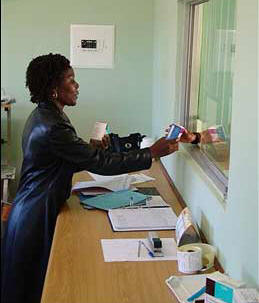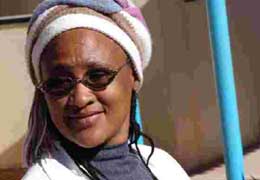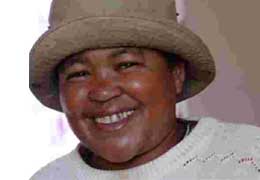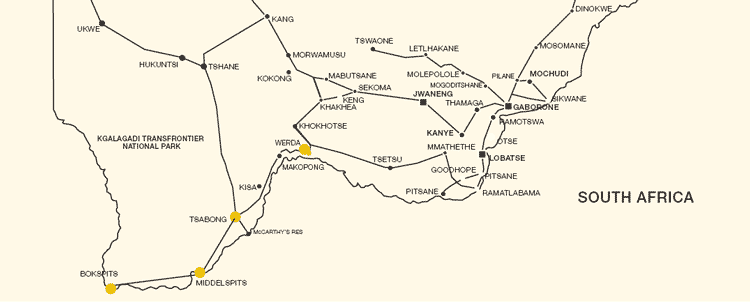ARVs Rolled Out to Remote Residents

Dr. Philip Mwala, of the PEPFAR Master Trainer Program, stands atop a dune in the Kgalagadi District, one of the first to roll out ARVs to remote residents.
Things changed when Sophia became sick with HIV/AIDS, a disease that took away her health and confidence. But more recently, with the help of life-saving ARV drugs, Sophia has won back her beauty pageant poise.
"I used to walk like this," she says, demonstrating her illness by crouching low, holding her stomach and moaning. Then, with a wide and toothy grin, she stands upright. "Now (with ARVs, I am like this again," she says, taking big steps with her head held high.
Sophia's story is one of many surfacing in far-off places like Bokspits, one of the most remote villages in the Kalahari where a growing number of people are benefiting from the anti-retroviral therapy (ART) program. Patients no longer have to travel hundreds of kilometers along some of Botswana's worst roads to get their medication. The Kgalahadi District is one of the first to successfully roll out treatment to several rural clinics, taking ART out to where people live.
For several years now, Botswana has been at the forefront of the response to the HIV/AIDS pandemic. In 2002, it was one of the first countries in Africa to provide its citizens free AIDS treatment, and now nearly 90 percent (around 82,500) of those estimated to need treatment are receiving it.
The U.S. government is supporting Botswana's treatment efforts with more than $18.5 million in FY2006 and $25.1 million in FY2007 from the President's Emergency Plan for AIDS Relief (PEPFAR). The support goes to purchase drugs, develop treatment guidelines, upgrade security in clinics and support training of health professionals who deliver ART services.
The challenge now for Botswana and its donors is to ensure access to treatment for people living in all corners of the country - from the swamps of the Okavango to the red sands of the Kalahari - leaving no one behind.
Rough Roads
Kgalagadi South District is an enormous, sparsely populated region of
southern Botswana sandwiched between the Kgalagadi Transfrontier Park and
the South Africa border. In many areas, Afrikaans is the first language
spoken and people slip freely across the border to visit relatives or work
at nearby farms.
Out of the 950 people currently on ARV treatment in the district, about half of them reside in remote villages (namely Bokspits, Middelspits and Werda) outside of Tsabong, the district headquarters where ARVs are dispensed from the primary hospital. Realizing that many people in these areas are unemployed with little or no income, and no transportation, district officials have pushed for the rollout of treatment to its satellite clinics.
Bokspits, a dusty village of less than 600 people, may be the best example of how difficult medical access can be for remote residents. Surrounded by red sand dunes, the village is 257 kilometers from Tsabong and the nearest primary hospital. There are no phone lines and often no electricity. Donkey carts are the only mode of transportation for most villagers.
"It is the most inaccessible site out there," says Dr. Philip Mwala, of the PEPFAR BHP Master Trainer Program, who has traveled to clinics around the country to conduct trainings and help with the rollout of ART. "The road to Bokspits is sand and gravel. A drive that should take two hours on a good road ends up taking up to six hours on this road, and that's in a big Land Crusier."
In addition to the poor roads, there is no public transportation. Most people either hitchhike or rely on government vehicles, which are often in disrepair (on a recent weekday, four of the five clinic vehicles for the Bokspits clinic and its surrounding health posts were inoperable). A traveler could wait two to three days for a ride to Tsabong, and when a lift does come it's often an uncomfortable and bumpy ride in the bed of a truck. If the traveler is sick, it can be downright torturous.
"The road is such mathatha (trouble)," explains Sophia, who had traveled it nearly once a month for doctor appointments. "You wait for so long to get a ride, than you are forced to sit in back and bounce without stopping. Even if you want to make water the drivers say ‘No stopping!"
The Kgalagadi District began rolling out ART in the village of Middelspits in August 2006, and then to Werda in April of this year. Steadily, patients who enrolled at the primary hospital in Tsabong will be transferred to one of these clinics. With a mobile caravan, the doctors in charge at the two clinics can then take treatment to Bokspits and other places at least once a month.
Nurses and lay counselors at the clinics and surrounding health posts say the rollout has already made an impact on their communities. "Word is getting out that ARVs are now available here, so we have seen people come in big numbers to test for HIV," says Lenah
Metswi, a lay counselor at Middelspits Clinic. "I think there is less hesitancy now knowing that they can get this service at home without having to travel so far."

Nurse Peggy Thumpe dispenses ARVs at the Middlespits Clinic.
The Rollout
Dr. Mutamba Yamutumba has worked as the only doctor in Middelspits since
November 2005. Originally from Kinsasha, the capital of the Democratic
Republic of the Congo (DRC) with 4.6 million people, he says moving to a
village of less than 2,000 was a "painful" experience. With no phone lines,
no local cell phone network and not even a copy machine, the clinic hardly
seemed prepared for an increase in clients or the rollout of ARVs. But with
construction of a new road and an increase in people testing for HIV,
Yamutumba knew the need would be great.
"Without proper communication, we were unsure whether we would be able to start the rollout here. But the DHT (district health team) was persistent and we just got it started," Yamutumba said. More than 100 new patients have registered at Middelspits since last August, and several are being "offloaded" or transferred from Tsabong every week.
The transition hasn't been easy for everyone. The DHT pharmacy technician in Tsabong has to travel to Middelspits and Wera every week, as well as Bokspits and other sites once a month to dispense drugs. It's an exhausting schedule for one person with a lot of responsibility. "It's tiresome, there is much to be done and the rest of my work is suffering," says Spiwe Gwenukwenu, the pharmacy technician. "But it's worth it. Patients are really benefiting from the drugs."
Part of the success and speed of the rollout is due to Dr. Mwala and his team at the Master Trainer Program, a PEPFAR-sponsored initiative supporting the government's ART program. Last year, more than 380 doctors, nurses and pharmacists received on-going training and 570 lay counselors and family welfare educators (FWEs) were mentored by the staff of the Master Trainer Program.
Dr. Mwala and his team do assessments of ARV sites, give lectures, advice and suggestions on enrollment procedures, adherence counseling and data management, as well as provide hands-on support with difficult patient cases. The Master Trainer program helped upgrade 10 satellite clinics last year.
Challenges
Kgalagadi
District clinics are still facing a number of challenges with the rollout of
ART, including delays in receiving laboratory results from Tsabong and
communication in general between the Matron's office and the clinics. If
Matron Eselinah Dube had a wish, she says, it would be to erect telephone
lines to Middelspits.
But according to the lay counselors at the grassroots level, the biggest challenges remain with the clients. Alcoholism, language barriers, illiteracy and migration to South Africa make follow-ups with patients difficult. "I do home visits and it's during these visits that the most education is done," says Hanna, a counselor at the Vaalhoek Health Post a few kilometers from the Bokspits Clinic where she was born 33 years ago. "I can speak to people in their first language (Afrikaans), which is good because sometimes the doctors will get it wrong if they are talking in English."
Dr. Mwala attributes the successes of the ART rollout to the motivated workers, especially people like Hanna who support the clinics and health posts at the grassroots level. "They're level of commitment and record keeping is remarkable," Mwala says. "Without them this couldn't have happened."

Dr. Mwala helped ready clinics for the rollout of ARVs

Lenah Metswi, a lay counselor at Middelspits Clinic, says patients have less
hesitancy coming forward for ARVs now that they know the service is
available close to home

Sofia, an ARV patient in Bokspits, is happy she no longer has to travel to
Tsabong every month for her medication
Map of Southern Botswana

